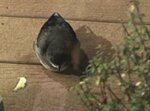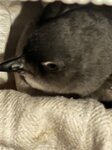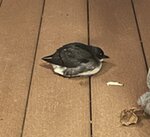


Last Friday I received a 10 p.m. phone call from one of my work colleagues. She and her husband live near Eld Inlet in western Thurston County. As they were closing their home for the evening, they noticed that they had an avian visitor on their porch. The initial description was that it could hardly walk and looked like a robin-sized penguin.
The question was, what kind of bird is this? Like many of us, they’re used to having the occasional bird strike a window, but though it was about the same size, this was no robin. Initially we wondered if it was a Marbled Murrelet, an endangered species. But after exchanging some more photos and discussing details, we all agreed that the mystery bird was a Cassin’s Auklet.
Here it is, after being bundled up for protection and put out a water dish. Its seabird-like bill, grey iris and small white slash above its eye are diagnostic of its species. In the morning, they were surprised to find the little bird sitting in the water dish! Quite a cute little thing.
Cassin’s Auklets are members of the large seabird family generally referred to as Alcids. This family includes Puffins and some birds commonly seen in Thurston County, the Pigeon Guillemot and in winter the Common Murre and Rhinoceros Auklet. They are all marine fish-eating birds that dive and swim underwater to catch their prey.
Perhaps more than any other bird family, the Alcids are adapted to marine life. They have powerful chest muscles and are capable of long flights. Their leg development, in contrast, is modest and legs are located far back on the body – a location well suited for propelling oneself underwater but not very efficient on porches. And, like other seabirds, they have a distinctive bill and nasal system that allows them to utilize saltwater.
Generally, the Alcids nest on offshore islands or inaccessible cliffs. (The Marbled Murrelet is an exception, nesting on large lateral branches of huge old growth trees inland from the coast. That’s the main reason they are endangered – lost nesting habitat). Some nest in cavities, others use scrapes on cliff edges.
Cassin’s Auklets are common birds in Washington State and up and down the Pacific Coast from the Aleutians to Baja California. They nest in colonies on numerous offshore islands, either digging a burrow in soil or utilizing rock crevices.
During breeding season, to avoid harassment by gulls and the like, they return to their nests after dark. Researchers report that one of the most remarkable bird experiences you can have is to be near a breeding colony at night when the air is filled with the eerie screeching of all the young, seeking to be fed.
The best advice for birders wanting to add Cassin’s Auklet to their list is to join a pelagic – that is, sea-going – birding trip. That’s because, although very common, these birds are seldom seen from shore since their range is far out to sea to feed. Our Eld Inlet bird was very far out of range and, incidentally, may be the first Thurston County record for this species.
So, what happened to this little night visitor? We are fortunate in Thurston County that we have Raindancer Wild Bird Rescue (http://www.raindancerwildbirdrescue.org/). The auklet’s hosts contacted Raindancer and, mid-day Saturday, the bird was delivered to this rescue service.
As you will read on its website, Raindancer specializes in the rehabilitation of orphaned or injured birds of prey, including eagles, osprey, hawks, falcons, kites, owls, and vultures. They sometimes take other bird species as time and resources allow. They encourage you to call or text at 360-970-5402 if you have found a bird in distress; they will advise you and may be able to help.
On initial assessment, it was apparent that our little auklet was not in good shape, although it was not injured (broken wing or the like). It was thin (feathers can hide an emaciated condition in birds) and it had pale tissue, suggesting malnutrition. Raindancer transferred the bird to a rehabilitator that specializes in seabirds. Unfortunately, by Monday, it had died.
This was not really a surprise since healthy seabirds do not typically land on suburban porches; but it is sad. It must be difficult to be a bird rescuer or rehabilitator.
The only silver lining in this sad story is that this little bird gave us all a chance to learn more about its species, and perhaps to concern ourselves more with the fate of our avian neighbors.
George Walter is environmental program manager at the Nisqually Indian Tribe’s natural resources department; he also has a 40+ year interest in bird watching. He may be reached at george@theJOLTnews.com. Photos for this column were provided by Margaret Homerding and are used by permission.
1 comment on this item Please log in to comment by clicking here
Terrilovesanimals
OH my gosh. So sad but I am so grateful to have a place around here that helps them! Also, want to thank you so much for this, as I learned a lot! Pretty birds!!
Monday, October 30, 2023 Report this